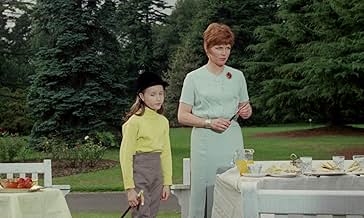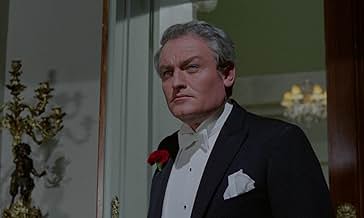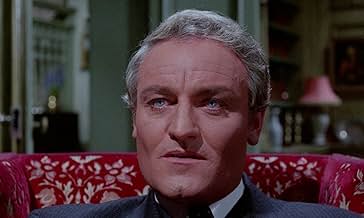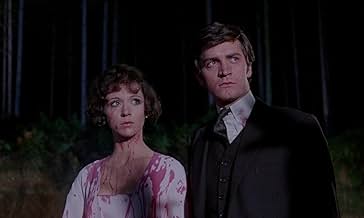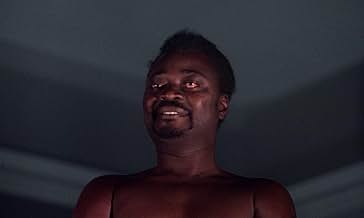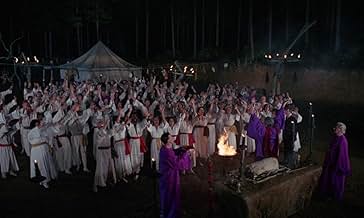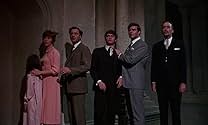IMDb रेटिंग
6.9/10
11 हज़ार
आपकी रेटिंग
अपनी भाषा में प्लॉट जोड़ेंDevil worshipers plan to convert two new victims.Devil worshipers plan to convert two new victims.Devil worshipers plan to convert two new victims.
- निर्देशक
- लेखक
- स्टार
Nike Arrighi
- Tanith Carlisle
- (as Niké Arrighi)
Yemi Goodman Ajibade
- African
- (बिना क्रेडिट के)
Patrick Allen
- Rex Van Ryn
- (वॉइस)
- (बिना क्रेडिट के)
Liane Aukin
- Satanist
- (बिना क्रेडिट के)
John Bown
- Receptionist
- (बिना क्रेडिट के)
Peter Brace
- Satanist
- (बिना क्रेडिट के)
John Falconer
- Satanist
- (बिना क्रेडिट के)
Anne Godley
- Satanist
- (बिना क्रेडिट के)
फ़ीचर्ड समीक्षाएं
One of Terrence Fisher's greatest directorial efforts certainly is this stylish, witty, thrilling adaptation of a Dennis Wheatley novel. Richard Matheson did the screenwriting honors, ad like most of what he touches, it turns to gold. This film has a wonderful score throughout, some superior set pieces and some pretty novel special effects for its day. But behind all of this is the central, universal battle between the forces of good and evil, represented by the characters of Christopher Lee and Charles Gray. Both actors do an excellent job. This may indeed be Christopher Lee's finest performance, which is all the more surprising since he not only plays a good man but also is in a role that Peter Cushing would have devoured. Lee, from the very onset of the film, plays a man well-versed in knowledge of the occult and whose presence literally steals scene after scene. His counterpart, the malevolent Charles Gray, is just as good as Lee's antithesis. Gray is an underrated actor whose presence also illuminates and transcends the screen. The film boasts some great scenes including the much heralded Angel of Death scene, and there is a great scene between Gray and Lee's niece. A tremendous film in many respects and one of Lee's best, Fisher's best and Hammer's best!
Dennis Wheatley's black magic novel gets the Hammer horror treatment, with Christopher Lee relishing the chance to play the good guy for once as the Duc De Richleau, an authority on the occult who does battle a group of Satanists (led by Charles Gray) for the soul of his friend. Made the same year as Rosemary's Baby, it was one of a number of films that brought Satan out of the shadows during the onset of the Summer of Love and is one of Hammer's best movies. Directed by the legendary Terence Fisher (The Curse of Frankenstein (1957), Dracula (1958), The Hound of the Baskervilles (1959) and The Mummy), from a screenplay written by Richard Matheson (of I Am Legend fame, the novel that spawned Last Man on Earth with Vincent Price, Omega Man with Charlston Heston and I Am Legend with Will Smith), it received praise from Wheatley himself and Christopher Lee said in interviews that it was one of his favorite onscreen performances. The cast includes Niké Arrighi as the sexy satanic neophyte Tanith Carlisle and Sarah Lawson and Leon Greene. The grinning Goat of Mendes in the film was played by Eddie Powell, who was Christopher Lee's stunt double in Hammer's 1958 adaptation of Dracula.
The Devil Rides Out (AKA: The Devil's Bride) is produced out of Hammer Film Productions. It's based on the 1934 novel of the same name written by Dennis Wheatley, with Richard Matheson adapting the screenplay. Directed by Terence Fisher, it stars Christopher Lee, Charles Gray, Nike Arrighi, Leon Greene, Patrick Mower, Sarah Lawson and Paul Eddington. Filmed in Technicolor with Arthur Grant the cinematographer and the music is scored by James Bernard.
1930's England and Duc de Ricleau (Lee) finds that his young friend Simon Aron has gotten himself involved with a Satanic cult led by the evil Mocata (Gray). As the Duc and his friends try to save Simon from the cult, Mocata and his followers summon the forces of evil to aid their cause.
It was meant to come out a bit earlier in the 60's, but Satanism, an always iffy subject, would have seen censorship strip Hammer's ideas for the film to the bone. So the studio waited a few more years and finally got the film out a couple of years shy of the 70's. It's a film that now, more than ever, is rightly viewed as not only one of the best film's to have come out of Hammer, but also as one of the best British horror movies ever released. There was much in the film's favour from the off, it had the studio's best director in the chair, the charismatic Christopher Lee in the lead and the talented Matheson (I Am Legend/The Shrinking Man/Hell House) writing the screenplay. The latter of which managing to streamline Wheatley's potent, but long, source material into a fast paced hour and a half movie. It's also, thanks to Wheatley, well researched, which when finding the story is set in more modern times, gives the film an authentic sheen as it rides on into the macabre.
On the surface the plot seems to be a standard good against evil battle, but it's not just a battle, this is a war on terror. Lee's determined, bastion of good, de Ricleau is not just fighting to save the soul of those he cares about, the film makes one feel that it's a battle he must win: for us all. Tho only blessed with the usual standard Hammer budget, the film has immense attention to detail, the power of black magic and the occult is painted vividly, with Fisher ensuring that nothing is hokey, this is serious stuff. The director, too, favouring atmospheric dread over short sharp shocks. What action there is is quality, sure the effects are hardly Oscar winning fare, but the impact is big. So too are the number of memorable scenes that puncture the story, the centrepiece of which is the night our "good" characters spend in floor drawn pentacle, fighting off the forces of darkness, some suggested trickery and terrifying manifestations testing their resolve, with the majestic Lee holding court with virtuous nobility.
The rest of the cast are uniformly excellent, with stand outs being Gray, excelling at silky villainy, even tho he's not on screen a great deal, and Eddington, who neatly plays it deadpan opposed to Lee's serious attempt to drive home the seriousness of what is going on. Noteworthy, too, that it's one of those rare occasions to see Lee playing the good guy. Grant (The Plague of the Zombies) makes wonderful use of the Technicolor, his lensing for the fire and brimstone finale is particularly memorable, and Bernard's score is eerie for the build up sequences and demonically boisterous for the critical moments: one of the best scores to accompany a Hammer film. It's not high cinematic art, and certainly not an overtly horrific film; in that you wouldn't recommend it to the boo-jump thrill seeker, but it's troublingly scary, adult and dripping with cold dread. A picture that closes in on you and challenges the myths and nightmares that lurk in the dark.
Up alongside The Wicker Man and Witchfinder General as one of the true greats of British horror. 9.5/10
1930's England and Duc de Ricleau (Lee) finds that his young friend Simon Aron has gotten himself involved with a Satanic cult led by the evil Mocata (Gray). As the Duc and his friends try to save Simon from the cult, Mocata and his followers summon the forces of evil to aid their cause.
It was meant to come out a bit earlier in the 60's, but Satanism, an always iffy subject, would have seen censorship strip Hammer's ideas for the film to the bone. So the studio waited a few more years and finally got the film out a couple of years shy of the 70's. It's a film that now, more than ever, is rightly viewed as not only one of the best film's to have come out of Hammer, but also as one of the best British horror movies ever released. There was much in the film's favour from the off, it had the studio's best director in the chair, the charismatic Christopher Lee in the lead and the talented Matheson (I Am Legend/The Shrinking Man/Hell House) writing the screenplay. The latter of which managing to streamline Wheatley's potent, but long, source material into a fast paced hour and a half movie. It's also, thanks to Wheatley, well researched, which when finding the story is set in more modern times, gives the film an authentic sheen as it rides on into the macabre.
On the surface the plot seems to be a standard good against evil battle, but it's not just a battle, this is a war on terror. Lee's determined, bastion of good, de Ricleau is not just fighting to save the soul of those he cares about, the film makes one feel that it's a battle he must win: for us all. Tho only blessed with the usual standard Hammer budget, the film has immense attention to detail, the power of black magic and the occult is painted vividly, with Fisher ensuring that nothing is hokey, this is serious stuff. The director, too, favouring atmospheric dread over short sharp shocks. What action there is is quality, sure the effects are hardly Oscar winning fare, but the impact is big. So too are the number of memorable scenes that puncture the story, the centrepiece of which is the night our "good" characters spend in floor drawn pentacle, fighting off the forces of darkness, some suggested trickery and terrifying manifestations testing their resolve, with the majestic Lee holding court with virtuous nobility.
The rest of the cast are uniformly excellent, with stand outs being Gray, excelling at silky villainy, even tho he's not on screen a great deal, and Eddington, who neatly plays it deadpan opposed to Lee's serious attempt to drive home the seriousness of what is going on. Noteworthy, too, that it's one of those rare occasions to see Lee playing the good guy. Grant (The Plague of the Zombies) makes wonderful use of the Technicolor, his lensing for the fire and brimstone finale is particularly memorable, and Bernard's score is eerie for the build up sequences and demonically boisterous for the critical moments: one of the best scores to accompany a Hammer film. It's not high cinematic art, and certainly not an overtly horrific film; in that you wouldn't recommend it to the boo-jump thrill seeker, but it's troublingly scary, adult and dripping with cold dread. A picture that closes in on you and challenges the myths and nightmares that lurk in the dark.
Up alongside The Wicker Man and Witchfinder General as one of the true greats of British horror. 9.5/10
'The Devil Rides Out' is easily one of the most entertaining of Terence Fisher's Hammer movies. While best known for his Dracula and Frankenstein movies, this fascinating blend of adventure thriller and Satanic shocker is not to be overlooked. While technically a horror movie with strong supernatural elements, the movie's use of old fashioned thrills and Lee's dashing heroic character Duc de Richleau, gentleman and occult expert, give this one quite a unique flavour unlike most of the other Hammer classics. Lee is brilliant throughout, as is his nemesis the evil magician Mocata played by Charles Gray (Blofeld in 'Diamonds Are Forever'). The rest of the cast are also very effective. Leon Greene as Richleau's loyal friend Rex, Nike Arrighi as Tanith the mysterious girl rex becomes besotted with, and Patrick Mower as Simon, Richleau and Rex's young friend who foolishly dabbles with Satanism and soon finds himself under the control of Mocasta. The film is consistently interesting, with lots of excitement and some unpredictable plot twists. The Satanism is treated more seriously and realistically than many 1960s horror movies (and wait til you see "The Goat Of Mendes"!) , and this is a credit to Richard Matheson who adapted Dennis Wheatley's original novel. I am becoming increasingly aware of just how many movies I admire that Matheson had a hand in writing - many of Roger Corman's Poe series, 'The Legend Of Hell House' and 'The Last Man On Earth' to name a few. Matheson is one of the most talented and imaginative horror writers to ever work in Hollywood, and rarely gets the credit he deserves. 'The Devil Rides Out' is yet another fantastic movie from the Hammer studio, and highly recommended.
Last night I saw this film for the first time in 35 years. Time has been kinder to it than it has to many Hammer films, but this one is less driven by effects and make-up and more by dialog.
That's all for the better because once again, when need be, Hammer fails in the effects department. I had forgotten how the theater went wild in 1968 while looking at the cheap tarantula effect - was it growing or not, the perspective changed constantly.
Some of the effects are of the "stop the camera" variety, no more convincing here than on "Lost In Space." But still, it is the performances, situations and the dialog that engage us. Christopher Lee, who brought the project to Hammer, seems to be enjoying himself as the Duc de Richleau, finally getting to play a hero. His longtime friend Rex, played by Leon Greene (but voiced by Patrick Allen) is a real stalwart guy, given to punching out windshields when necessary, climbing into car trunks, and throwing a crucifix from a running board to eliminate the specter of the devil himself.
The best scene has Lee and company in a circle in which to protect themselves from the evils sent by Mocata, played by Charles Gray with a suaveness that matches the twinkle of his blue eyes. Mocata tries every trick in the book, including trying to make it appear that the daughter of the household is being threatened by the tarantula, as well as an Angel of Death on horseback (it is a large room). Meanwhile, outside, Rex has a potential female victim tied up for her own good, she later becomes a medium when the previously "threatened" little girl is kidnapped - to take the place of the medium on the sacrificial altar!
Nike Arrighi plays the "medium" - a young woman who was to have been re-baptized as a servant of the devil, but whose life now hangs in the balance between the black magic of Mocata, or the efforts of the Duc de Richleau, and she has more talent than most of the Hammer actresses of the period. The Duc's friend Rex falls for her, but is hard pressed to keep up with the spells of Mocata, who will stop at nothing to reclaim his servant.
What really helps the film is a great sense of period - somewhere midway between the two world wars. The props (especially the vehicles) and costumes are quite right, and the landscapes are far more diverse than the usual Bray Studios trappings. There's no doubt that the team sought to make this one special and shoot on some real locations - and it's perhaps here rather than in the effects that the budget was concentrated. All in all, despite some shortcomings, a very enjoyable Hammer film, a solid Richard Matheson script from a superior Dennis Wheatley novel makes for exciting viewing, far superior to the previous Satanic Hammer film "The Witches" (aka "The Devil's Bride") and equal to the later adaptation of Wheatley's own "To the Devil A Daughter" - the last Hammer film which may have its less than sterling reputation for that measure alone.
That's all for the better because once again, when need be, Hammer fails in the effects department. I had forgotten how the theater went wild in 1968 while looking at the cheap tarantula effect - was it growing or not, the perspective changed constantly.
Some of the effects are of the "stop the camera" variety, no more convincing here than on "Lost In Space." But still, it is the performances, situations and the dialog that engage us. Christopher Lee, who brought the project to Hammer, seems to be enjoying himself as the Duc de Richleau, finally getting to play a hero. His longtime friend Rex, played by Leon Greene (but voiced by Patrick Allen) is a real stalwart guy, given to punching out windshields when necessary, climbing into car trunks, and throwing a crucifix from a running board to eliminate the specter of the devil himself.
The best scene has Lee and company in a circle in which to protect themselves from the evils sent by Mocata, played by Charles Gray with a suaveness that matches the twinkle of his blue eyes. Mocata tries every trick in the book, including trying to make it appear that the daughter of the household is being threatened by the tarantula, as well as an Angel of Death on horseback (it is a large room). Meanwhile, outside, Rex has a potential female victim tied up for her own good, she later becomes a medium when the previously "threatened" little girl is kidnapped - to take the place of the medium on the sacrificial altar!
Nike Arrighi plays the "medium" - a young woman who was to have been re-baptized as a servant of the devil, but whose life now hangs in the balance between the black magic of Mocata, or the efforts of the Duc de Richleau, and she has more talent than most of the Hammer actresses of the period. The Duc's friend Rex falls for her, but is hard pressed to keep up with the spells of Mocata, who will stop at nothing to reclaim his servant.
What really helps the film is a great sense of period - somewhere midway between the two world wars. The props (especially the vehicles) and costumes are quite right, and the landscapes are far more diverse than the usual Bray Studios trappings. There's no doubt that the team sought to make this one special and shoot on some real locations - and it's perhaps here rather than in the effects that the budget was concentrated. All in all, despite some shortcomings, a very enjoyable Hammer film, a solid Richard Matheson script from a superior Dennis Wheatley novel makes for exciting viewing, far superior to the previous Satanic Hammer film "The Witches" (aka "The Devil's Bride") and equal to the later adaptation of Wheatley's own "To the Devil A Daughter" - the last Hammer film which may have its less than sterling reputation for that measure alone.
क्या आपको पता है
- ट्रिवियाThe film was made at Christopher Lee's insistence that Hammer do a movie based on a Wheatley fantasy novel.
- गूफ़During the opening credits, a symbol is shown that is not Satanic, and it is also incorporated into the symbol on the priestly robes during the film. Inscribed within a Star of David, there is a six-winged seraph with the faces of a man, lion, ox and eagle based on the vision of Ezechiel. In Christian tradition, the four faces become associated with the four gospel writers: Matthew, Mark, Luke and John.
- भाव
Marie Eaton: [to her servant about Mocata] Show him out!
Mocata: I'm leaving.
[walks towards door and stands behind Marie]
Mocata: *I* shall not be back... but something will.
[pauses menacingly]
Mocata: Tonight! Something will come for Simon and the girl!
[leaves]
- इसके अलावा अन्य वर्जनThe 2012 UK Blu-ray Disc released by Studio Canal features digitally enhanced special effects. The makers of the Blu-ray claim to complete shots which had never been finished due to budget reasons:
- Matte shot of Simon's mansion with the Observatory dome has been replaced with a CGI background.
- During the ritual at the climax of the movie a lighting has been replaced with a new CGI lightning.
- Spider sequence: Shadow for the spider has been added, some matte shots enhanced, and digital smoke added when the spider is sprayed with holy water.
- The Angel of Death sequence: A light effect is illuminating the door to cover the poor original optical effect when the angel rides through the door. The close up of the Angel of Death has a new background with flames as the original intended shot was never finished.
- The matte shots of Charley Grey's death in the fire have been digitally corrected as there were optical errors in the layers of the matte shots.
- Several other matte shots have been improved by removing matte lines.
- कनेक्शनFeatured in Iron Maiden: The Number of the Beast (1982)
टॉप पसंद
रेटिंग देने के लिए साइन-इन करें और वैयक्तिकृत सुझावों के लिए वॉचलिस्ट करें
विवरण
- रिलीज़ की तारीख़
- कंट्री ऑफ़ ओरिजिन
- भाषा
- इस रूप में भी जाना जाता है
- The Devil's Bride
- फ़िल्माने की जगहें
- उत्पादन कंपनियां
- IMDbPro पर और कंपनी क्रेडिट देखें
- चलने की अवधि1 घंटा 36 मिनट
- पक्ष अनुपात
- 1.66 : 1
इस पेज में योगदान दें
किसी बदलाव का सुझाव दें या अनुपलब्ध कॉन्टेंट जोड़ें



